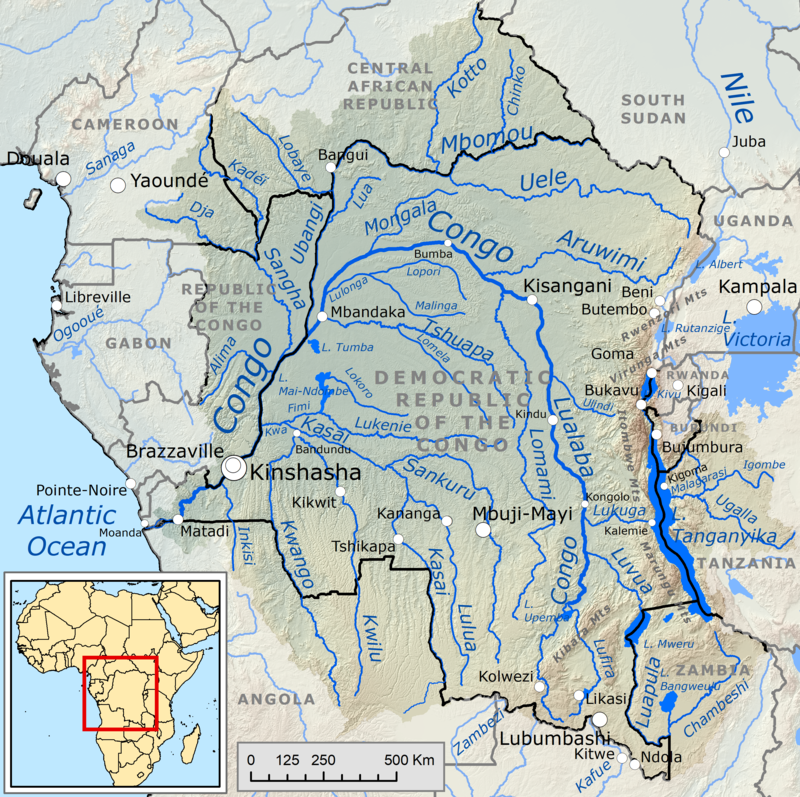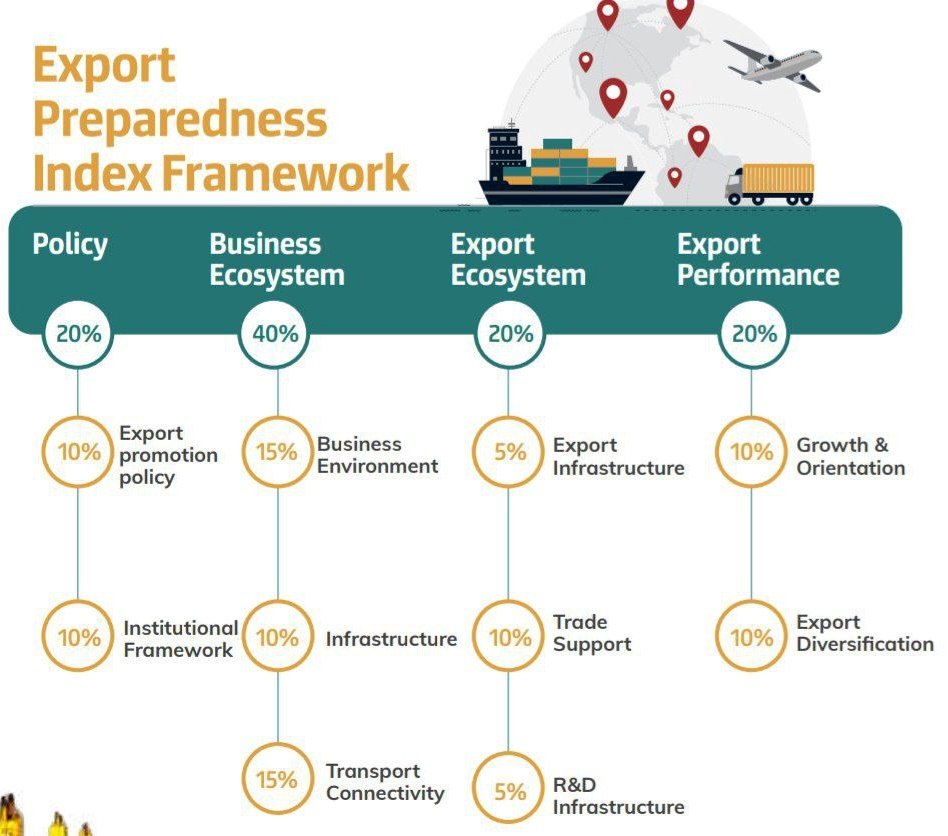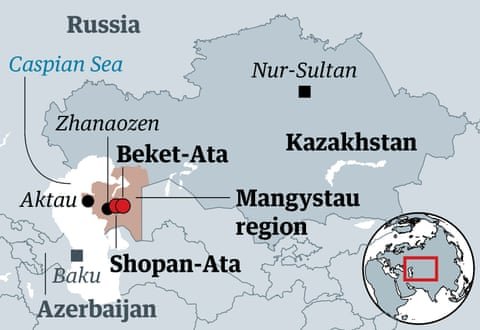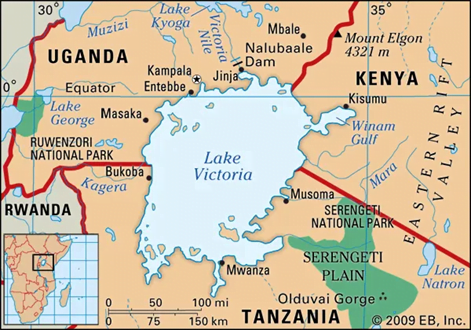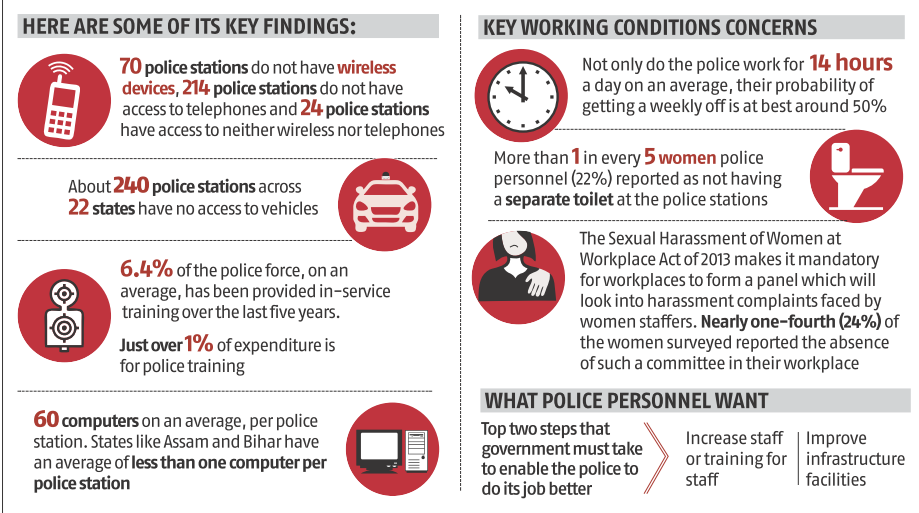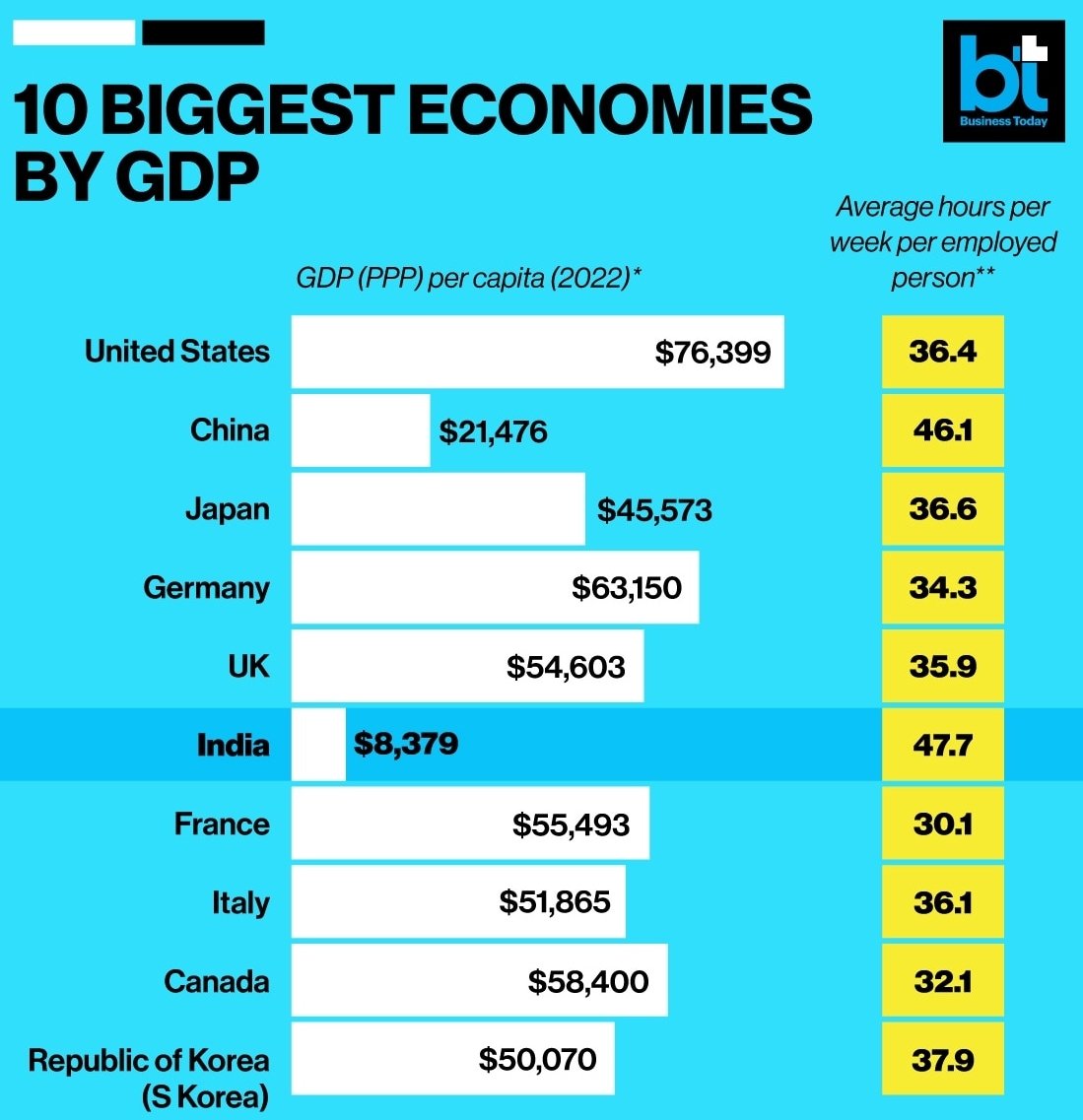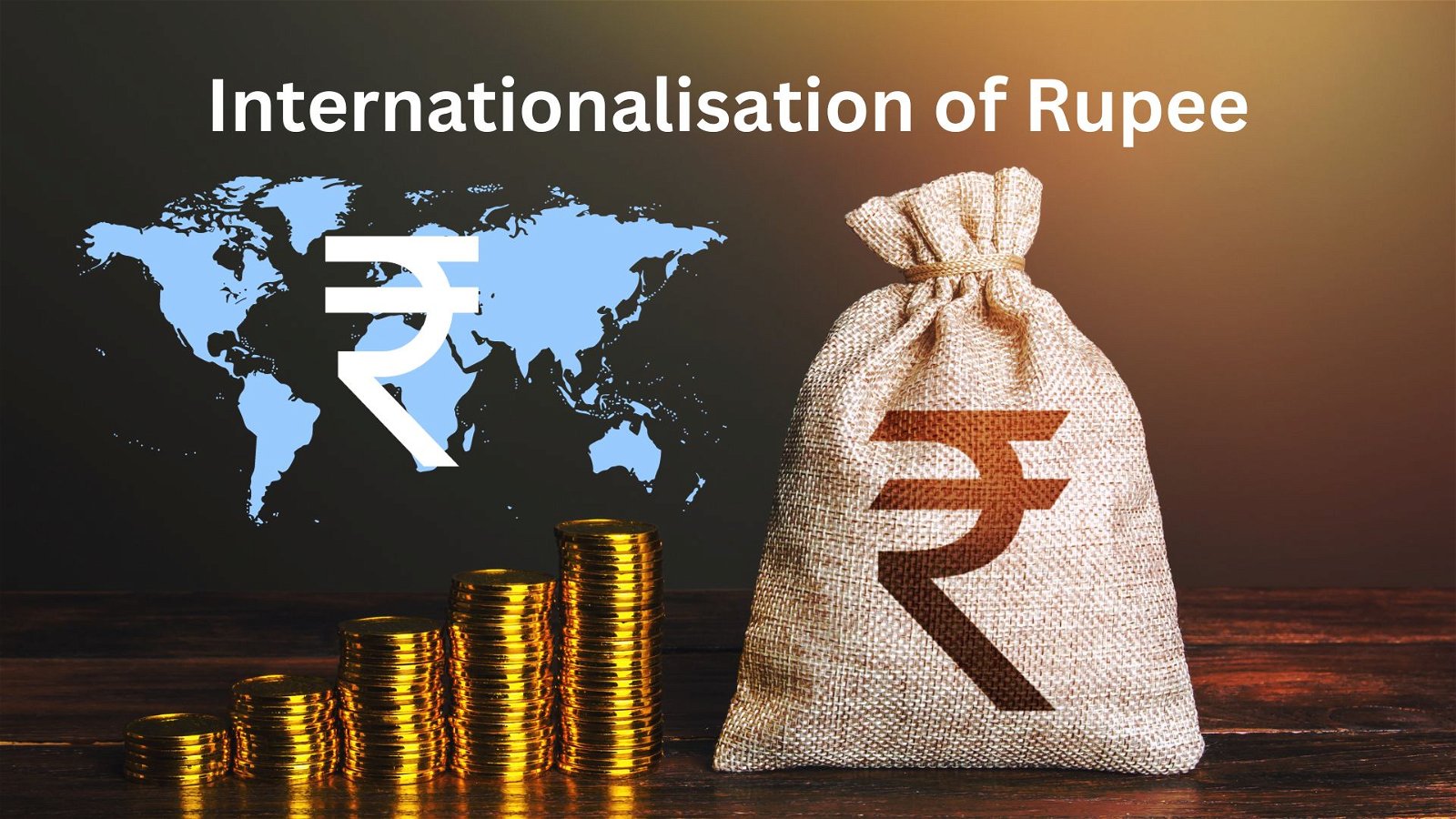
Current Affairs for UPSC Civil Services Exam – March 12, 2024
Subscribers of "Current Affairs" course can Download Daily Current Affairs in PDF/DOC
Subscribe to Never Miss an Important Update! Assured Discounts on New Products!
Must Join PMF IAS Telegram Channel & PMF IAS History Telegram Channel
{GS2 – MoAFW – Initiatives} Initiatives of Agriculture Sector
- Context (PIB): The Ministry of Agriculture & Farmers Welfare has introduced 4 key initiatives of the Agriculture Sector.
- The objective of these initiatives is to benefit farmers and enable them to farm more easily.
Revamped Soil Health Card Portal and Mobile Application
- The portal offers a soil lab registry with mapped geo-coordinates, real-time tracking of soil sample collection, lab testing, and generation of Soil Health cards.
- It includes features like fertiliser management, Emoji-based Soil Health Cards, nutrient dashboards, and nutrient heat maps.
- Farmers can download Soil Health Cards via SMS notification or by entering their mobile number on the portal.
- A centralised dashboard and real-time Geographic Information System (GIS) analytics are provided at the national, State, and district levels.
- An app-based QR code-enabled soil sample collection system has been introduced in the Soil Health Card Mobile Application.
- The app also registers plot details and is workable in online and offline modes.
School Soil Health Programme
- It is an initiative undertaken by the Department of Agriculture and Farmers Welfare in collaboration with the Department of School Education and Literacy.
- The pilot project established 20 soil labs in Kendriya Vidyalaya and Navodaya Vidyalaya schools located in rural areas.
- The programme has been scaled up in 1000 schools. Kendriya Vidyalya, Navodaya Vidyalya and Eklavya Model Schools have been taken under this programme.
- National Bank for Agriculture and Rural Development (NABARD) will facilitate the establishment of soil labs in these schools.
- Students will collect soil samples, conduct tests, and generate Soil Health Cards. After generating the cards, students will educate farmers about the recommendations.
Krishi Sakhi Convergence Programme
- It is an initiative of the Ministry of Agriculture & Farmers’ Welfare and the Ministry of Rural Development.
- Objective: To empower farmers, especially those in remote areas, by providing them with essential tools and knowledge from Krishi Sakhis.
- Under their leadership, soil laboratories have been established in rural Kendriya and Navodaya Vidyalayas.
- Students and teachers are trained to participate in village development and the agriculture sector actively.
Krishi Sakhis
|
Central Fertilizer Quality Control and Training Institutes (CFQCTI) Portal
- The CFQCTI operates the Fertiliser Quality Control Portal, which provides essential information related to fertilisers.
- This initiative aims to enhance quality control and ensure safe fertilisers for agricultural use.
{GS2 – MoC – Initiatives} Adopt a Heritage 2.0 Programme
- Context (PIB): The Archaeological Survey of India (ASI) has envisioned the ‘Adopt a Heritage 2.0′ programme for the preservation and promotion of India’s cultural heritage.
- Adopt a Heritage 2.0 programme is a revamped version of the earlier scheme (Adopt a Heritage Scheme} launched in 2017 and clearly defines the amenities sought for different monuments as per AMASR Act 1958.
- It emphasizes the collective responsibility of both public and private entities in safeguarding India’s heritage for future generations and enhancing end-to-end experience for visitors.
- The selected agencies, termed “Smarak Sarathi/Sathi,” will be responsible for providing and maintaining amenities in hygiene, accessibility, safety, and knowledge categories.
- The term of the appointment will be for a period of five years initially, which may be further extended up to five years.
- The programme encourages corporate stakeholders to utilise their Corporate Social Responsibility (CSR) funds to enhance facilities at historically important monuments.
{GS2 – MoCF – Schemes} RPTUAS Scheme
- Context (PIB): The Ministry of Chemicals and Fertilizers announced the Revamped Pharmaceuticals Technology Upgradation Assistance (RPTUAS) Scheme.
- The RPUTAS scheme aims to upgrade the technological capabilities of the pharmaceutical industry in India and align it with global standards.
- It supports pharmaceutical industry’s upgradation to Revised Schedule-M and WHO-GMP (Good Manufacturing Practices) standards, enhancing quality and safety of pharmaceutical products manufactured in the country.
Key Features
- Broadened Eligibility Criteria: Any pharmaceutical manufacturing unit with a turnover of less than 500 crores though it gives preference to MSMEs.
- Flexible Financing Options: Subsidies on reimbursement basis, diversifying financing options for participating units.
- State Government Schemes Integration: enabling units to benefit from additional top-up assistance.
- Enhanced Verification Mechanism through a Project Management Agency to ensure transparency, accountability, and efficient resource allocation.
- Dynamic Incentive Structure: Units with different turnover levels are eligible for incentives ranging from 10% to 20% of investment under eligible activities.
- Eligible activities include improvements such as HVAC systems, water and steam utilities, testing laboratories, clean room facilities, etc.
| Turnover | Incentives |
| Turnover >Rs. 50.00 crore | 20% of investment under eligible activities |
| Turnover from Rs. 50.00 Cr to >Rs. 250.00 crore | 15% of investment under eligible activities |
| Turnover from Rs. 250.00 Cr to >Rs. 500.00 crore | 10% of investment under eligible activities |
{GS2 – Polity – IC – Judiciary} Judges Joining Politics
- Context (TH I DC I IE): Justice Abhijit Gangopadhyay recently resigned as a judge of the Calcutta HC and joined the Bharatiya Janata Party (BJP).
- In 1967, Chief Justice Koka Subba Rao resigned to contest the presidential elections.
- In 1983, the SC judge Baharul Islam resigned to get elected as a member of the Rajya Sabha.
- Mr. Gangopadhyay was often in the news for the wrong reasons-
- He gave an interview to a TV channel criticising the WB government and speaking about the school job-for-bribe case.
- He created controversy by defying an order of a division bench. Sometimes he had run-ins with lawyers and even fellow judges.
- On Mr. Gangopadhyay’s conduct, a bench of CJI D.Y. Chandrachud and Justice P.S. Narasimha rightly said that judges have no business giving TV interviews on pending matters.
- The orders delivered by Mr. Gangopadhyay had far-reaching implications-
- On the fate of thousands of job aspirants, teachers and non-teaching staff,
- It also dominated the political discourse in West Bengal since 2021.
Constitutional Debate on Judges Conduct and Joining Politics
- Against Joining Politics:. A member of the Constituent Assembly (CA), K.T. Shah, had suggested that judges of constitutional courts should be legally barred from occupying executive posts.
- In Favour of joining Politics: CA did not find favour with this.
- Implementing external rules to control the judicial behaviour of judges would be antithetical to the idea of judicial independence.
- India has never legislated over the judicial conduct of judges of constitutional courts.
Constitutional Provisions related to Powers and Privileges of Judges
- The basis for judicial privilege arises from the need to preserve the confidentiality of the judicial decision-making process.
- The constitutional basis for judicial privilege stems from the doctrine of the separation of powers and the need to preserve the independent functioning of the judicial branch.
Removal of Judges
- Article 217 read with Article 124(4) of the IC is the way to remove a judge by the way of impeachment by Parliament.
Contempt Power
- Article 215 declares the HCc to be a court of record with contempt power which the judges could invoke.
Governing Judges Conduct
Constitutional Provisions
- Paragraph VIII of the Third Schedule of the IC demands a judge-designate to swear that he will perform his duties without fear or favour, affection or ill-will.
The Bangalore Principles of Judicial Conduct (2002)
- It gained international acceptance as indicated by the Judicial Integrity Group.
- The declaration enlists certain judicial values including independence, impartiality, integrity, propriety, equality, competence and diligence.
- It emphasises the need to eradicate bias or prejudice in the decision-making process.
- Judges to ensure that their conduct “both in and out of (the) court maintains and enhances the confidence of the public, the legal profession, and litigants in the impartiality of the judge and of the judiciary”.
- It is against the judge making comments “that might reasonably be expected to affect the outcome of (a case).”
- “Judge shall disqualify himself or herself from participating in any proceedings in which the judge is unable to decide the matter impartially”.
- “A judge shall conduct themselves in a way that is consistent with the dignity of the judicial office”.
Restatement of Values of Judicial Life 1997
- The SC of India adopted the Restatement of Values of Judicial Life in 1997, outlining ethical standards and principles for judges. Some key points from the Restatement include:
- Impartiality: Justice must not only be done but also be seen to be done. Judges’ behaviour should reaffirm people’s faith in the judiciary’s impartiality.
- Avoiding Conflicts: Judges should avoid close associations with individual members of the Bar, refrain from hearing cases involving family members who are lawyers, and not enter public debates on political matters.
- Financial Benefits: Judges should not seek financial benefits unless clearly available and should not speculate in shares or engage in trade or business.
- Public Gaze: Judges must always be conscious that they are under public scrutiny, and their actions should benefit the high office they occupy.
Ethical Concerns Related to the Resignation of a Judge for Politics?
Judicial Impartiality
- Judges are expected to remain neutral and make decisions based solely on the facts and the law, without being influenced by personal biases and external pressures.
- The sitting judge joining a political party after being involved in controversies raises questions about his impartiality while presiding over cases involving political matters.
- This undermines public confidence in the judiciary’s ability to dispense justice fairly.
Judicial Independence
- Judicial independence is crucial for maintaining the rule of law and democracy.
- Judges must be free from interference or influence from any outside parties, including political entities.
- Judge aligning themselves with a political party shortly after their resignation/retirement calls into question the independence of his previous judicial decisions.
- It also raises concerns about the influence of political considerations on the judiciary’s functioning.
Conflict of Interest
- Judges are expected to avoid conflicts of interest & maintain the integrity of the judicial process.
- Their involvement in political activities, after making controversial statements and rulings, raises concerns about potential conflicts of interest.
Public Trust and Confidence
- The judiciary relies on public trust and confidence to fulfill its role in society. Judiciary’s actions undermining the judicial integrity and impartiality, erodes public trust in the entire judicial system.
- Transition from the judiciary to active involvement in politics leads to scepticism and cynicism among the public.
Issue of Post-Retirement Appointments
- Some retired judges have accepted government posts after retirement. This practice blurs the clear demarcation between the judiciary and the executive.
Post-Retirement Assignments for Judges
- The IC doesn’t explicitly prohibit judges from taking up post-retirement assignments but there have been suggestions for implementing a cooling-off period to mitigate potential conflicts of interest.
- Former Union Minister Late Arun Jaitley had said “Pre-retirement judgments are influenced by post-retirement jobs”.
- The 14th Law Commission Report, 1958: Highlighted the concern and advocated for a system that ensures financial security to the judges without compromising independence.
- Former CJI R M Lodha recommended a cooling-off period of at least 2 years.
- Officials who retire from sensitive positions should be barred from accepting any other appointment for some time, normally two years.
- These cooling-off periods in posts are premised on the snapping off of the nexus between previous incumbency and new appointment by the interposition of a sufficient time gap.
- International Practices:
- In the USA, SC justices do not retire but hold their positions for life to prevent conflicts of interest.
- In the UK, while there is no law preventing judges from taking post-retirement jobs, no judge has done so, reflecting a different approach to the issue of post-retirement roles.
{GS2 – Social Sector – Health – Disease} Cervical Cancer
- Context(TH): Human Papilloma Virus (HPV) vaccines can prevent cervical cancers that can seriously affect a woman’s health.
- Cervical cancer in humans is caused by certain types of Human papillomaviruses (DNA virus).
Cervical Cancer: A Global and Indian Perspective
Global
- It is the fourth most common cancer among women worldwide.
- It claims the lives of more than 3,00,000 women every year, or one life every two minutes.
- Nine out of 10 women dying of cervical cancer live in lower- and middle-income countries.
India
- In India, cervical cancer is the second most common cancer after breast cancer.
- Given the country’s population size, about 500 million women above the age of 15 are at risk of cervical cancer.
- With the current population growth rate, the absolute number of new cases of cervical cancer for all ages in India in 2040 is estimated to be 1,91,347 (an increase of 54% ocompared to 2020).
Issues or challenges
- Accessibility of HPV vaccine for girls in India is limited, often requiring out-of-pocket expenses in the private market.
- Underestimation by the physicians regarding the incidence and risk of cervical cancer along with HPV infection.
- Lack of awareness among physicians regarding the safety and effectiveness of HPV vaccines.
- Mistrust in vaccine safety and effectiveness contributes to hesitancy in recommending the HPV vaccine to parents of eligible adolescents.
- Some physicians hesitate due to the mode of transmission, as HPV infections primarily occur through intimate skin-to-skin contact.
- Universal Immunisation Programme (UIP) does not include HPV vaccines.
Way forward
- Elimination of cervical cancer is a real possibility via HPV vaccination and screening for precancerous lesions.
- Implementation of the WHO’s strategy that aims for a 90-70-90 triple pillar intervention and high-quality and equitable healthcare services by 2030.
- 90% of girls are fully vaccinated with the HPV vaccine by age 15.
- 70% of women screened using a high-performance test by ages 35 and 45.
- 90% of women with cervical pre-cancer and cancer lesions must receive treatment and care.
 |
{GS2 – Social Sector – Health – Issues} Ban on Rhodamine-B
- Context (NDTV | LM | TH | HT | IE): Recently, Karnataka government banned the use of Rhodamine-B, a food colouring agent commonly used in popular dishes like gobi manchurian and cotton candy.
- Eateries use Rhodamine-B to make food items look more red.
- Consumption of snacks containing these artificial colours may pose long-term health risks, including cancer.
- Earlier, Tamil Nadu and Puducherry too had prohibited the sale of cotton candy when Rhodamine-B samples were discovered in them.
- Not following the government order can lead to seven years or life imprisonment and a fine of up to ₹10 lakh.
Permitted Synthetic Colouring Agents
- According to the Food Safety and Standards Authority of India (FSSAI), no colouring matter should be added to food unless permitted in the Food Safety and Standards (Food Products Standards and Food Additives) Regulation, 2011.
- The permitted synthetic colouring agents are:
- Red – Ponceau 4R, Carmoisine, Erythrosine
- Yellow – Tartrazine, Sunset Yellow FCF
- Blue – Indigo Carmine, Brilliant Blue FCF
- Green – Fast Green FCF
Rhodamine – B

- It is a water-soluble synthetic compound and a fluorescent dye.
- It is pink to reddish-brown powder or crystals.
- It is commonly used in microscopy, flow cytometry, dye lasers and fluorescence imaging.
- It is also used as a colouring agent in products like inks, cosmetics, textile dyeing and the paper industry.
- This compound is frequently used as a food colourant, particularly in items like chilli powder and chilli oil.
- The chemical is toxic for humans and can cause oxidative stress on cells and tissues if ingested.
- As per the Food Safety Standards Act, 2006, preparation, packaging, importing, selling and serving food items with Rhodamine-B in wedding ceremonies and other public events is a punishable offence.
Tartrazine

- It is a synthetic food colourant classified as an azo dye. It is lemon yellow in color and water soluble.
- It can be used in drugs, cosmetics, and foods, including soft drinks, chips, pudding, honey, pickles, gum, mustard, gelatin, and baked goods.
- Tartrazine cannot be used for freshly prepared food items.
{GS3 – Agri – Tech} National Speed Breeding Crop Facility
- Context (PIB): Union Minister of Science & Technology inaugurated the first-of-its-kind “National Speed Breeding Crop Facility” at the National Agri-Food Biotechnology Institute (NABI) in Mohali.
- The facility will be used to develop new crop varieties such as wheat, rice, soybeans, peas, and tomatoes by achieving more than four generations of a crop per year in a precisely controlled environment.
- It aims to provide farmers with the opportunity to improve crop quality and quantity through advanced crop varieties and speed breeding cropping methods.
- The initiative aligns with doubling farmers’ income, empowering them economically, and promoting Agri-StartUps.
{GS3 – S&T – Defence} Agni 5 with MIRV technology
- Context (IE | TH | HT | PIB | IE | IE): India declared the successful test of the indigenously developed Agni-5 missile on Monday. The test was named Mission Divyastra.
- The missile can carry multiple warheads, targeting multiple locations at the same time.
- The test was carried out from Dr APJ Abdul Kalam Island, off the coast of Odisha, which hosts India’s integrated missile test range.
- The project was steered by a woman scientist of DRDO, and it involved other women scientists too.
Agni missiles
- Agni missiles are the mainland-based delivery systems for India’s nuclear weapons.
- The initial Agni missiles were created in the 1990s and entered armed forces deployment in the mid-2000s.
- Ranging from Agni-1 to Agni-IV, these missiles cover distances between 700 to 3,500 km and carry single payloads weighing 12 to 40 kilotons.
- Agni-5, the latest version with MIRV technology, surpasses 5,000 km in range and could potentially reach the intercontinental range of 5,500 km and beyond.
- The next generation Agni-6 missile is currently under development.
Agni-5 missiles
- In 2007, India declared the development of Agni V.
- Agni-5 missiles are long-range missiles (5,000 km) created by DRDO.
- It uses a three-stage solid fuelled engine.
- It is capable of carrying nuclear warheads.
- It is aimed mainly at thwarting China’s challenge.
- The latest Agni variant features MIRV (Multiple Independently Targetable Re-entry Vehicle) technology.
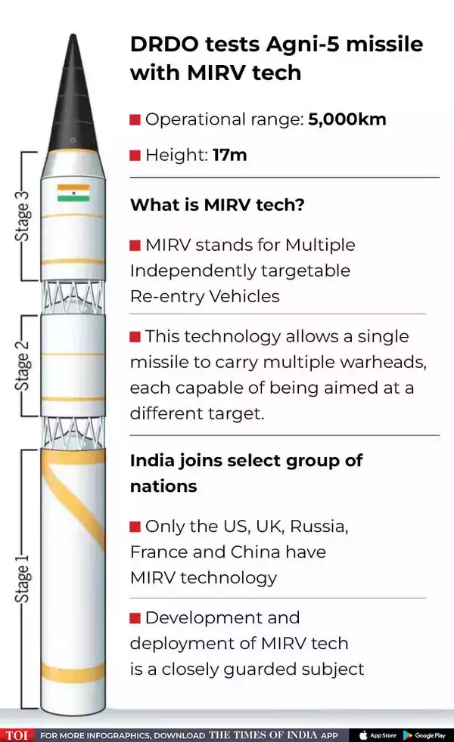
MIRV technology
- The MIRV can target multiple targets that can be hundreds of kilometers apart with a single missile.
- Warheads on MIRVed missiles can be released from the missile at different speeds and in different directions.
- As of now, the United States, Russia, China, France and the United Kingdom are known to have MIRV-equipped missiles. India has now joined the club.
- Pakistan too has claimed to have tested an MIRV-equipped missile called Ababeel, first in 2017 and then in 2023.
- MIRV-equipped missiles have never been used so far in any conflict situation.
Advantages of MIRV technology
- Prevent an imbalance in land-based ballistic missile forces, as India has a limited number of missiles targeting Chinese cities.
- Ensure India doesn’t lag too far behind in establishing a credible sea-based nuclear deterrent, given China’s more advanced program for nuclear-powered ballistic missile submarines (SSBNs).
- MIRVs has the ability to penetrate missile defence systems. So it is seen as a hedge against the potential deployment of a ballistic missile defence system by China in the future.
- With its ability to inflict severe damage in a retaliatory strike it can act as a powerful deterrent to potential adversaries.
Agni P
Missile defense system
|
{GS3 – S&T – Tech} Apple’s Post-quantum Cryptographic Protocol (PQ3)
- Context(TH): Recently, Apple announced PQ3, a post-quantum cryptographic protocol, to encrypt conversations in iMessage.
- The company called it the first messaging protocol to reach Level 3 security. They assert it can withstand even highly sophisticated quantum attacks.
What is PQ3 Protocol?
- At the moment, communication security is measured by three security levels.
- Level 0: In this level, the messages remain unencrypted.
- Level 1: Here messages are end-to-end encrypted but there’s no additional identity authentication or quantum security.
- Level 2: This includes identity authentication and quantum security but they are limited to the initial key establishment. This means quantum security is offered only if the conversation key material is never compromised.
- Level 3: PQ3 is the first messaging protocol that qualifies for what Apple calls Level 3 security.
- This uses post-quantum cryptography to secure both the initial key establishment and the ongoing message exchange.
- In addition, the Level 3 PQC can automatically restore the security of a conversation even when the key is compromised.
- Therefore, PQ3 is claimed to surpass protocols in all other widely deployed messaging apps.

How Does PQ3 Protocol Work?
- Apple’s PQ3 protocol uses a hybrid design combining the traditional encryption methods with post-quantum encryption both during the initial key establishment between devices and during rekeying.
- Each device generates public keys locally and then transmits them to Apple servers as part of the iMessage registration process.
- For this, Apple uses the Module Lattice-based Key Encapsulation Mechanism standard or ML-KEM.
- It enables the sender devices to get a receiver’s public keys and generate post-quantum encryption keys for the very first message. This works even if the receiver is offline.
- Then Apple includes a periodic post-quantum rekeying mechanism within the conversation. This mechanism can self-heal from key compromise and safeguard future messages.
- In PQ3, the new keys sent along with the conversation are used to create fresh message encryption keys that can’t be computed from past ones. Thereby bringing the conversation back to a secure state even if previous keys were extracted or compromised by an adversary.
Why is Apple Shifting to PQ3 Protocol for iMessage?
- The existing common cryptographic algorithms used by messaging apps rely on mathematical problems that could potentially be solved by sufficiently powerful quantum computers, which don’t exist today.
- However, resourced attackers can do the homework before future arrival. Such attackers can manage to collect large amounts of encrypted data and store it for future reference.
- Although they can’t decrypt any of this collected data today, they can do it in the future using a quantum computer. This attack scenario is known as Harvest Now, Decrypt Later.
- The iMessage’s new security protocol, PQ3, is designed to protect users against Harvest Now, Decrypt Later attacks.
To know more about different types of encryption Algorithms, visit> Common encryption algorithms.
{Prelims – Envi – Species} Cycas circinalis (Eenthu Pana)
- Context(TH): Cycas circinalis, popularly known as Eenthu Pana in Kerala, is on the verge of extinction in the northern part of Kerala after being hit by an unknown plant disease.

- Cycas Circinalis, also known as the Queen Sago Palm, is actually a species of cycad, not a palm.
- Native to southern India and Sri Lanka. Among the nine cycad species identified in India, six are native to the country.
- Distribution: It is found exclusively in the Western Ghats region, spanning the states of Kerala, Karnataka, Tamil Nadu, and southern Maharashtra.
- It is an evergreen tree reaching heights of up to 25 feet.
- It is commonly found in dense, scrubby woodlands in hilly regions that experience seasonal dryness.
- Cycas are known to be the oldest living species on Earth. These plants originated 300 million years ago during the Carboniferous period.
- It is a valuable plant used for nutrition by many local communities in the Western Ghats.
- They bear fruit after 40 to 50 years.
|
{Prelims – In News} Modi Script
- Context (IE): The Vijay Nagar Primary Zilla Parishad school in Maharashtra has initiated a unique program to revive the ancient ‘Modi’ script of Marathi.
- Modi was a script used to write Marathi for an estimated 700 years. Today, Marathi is written only in Devanagri.
- Its name is directly derived from the Marathi verb “modane”, which means “to bend or to break”.
- The script is estimated to date back to the 14th century, although the documents we have are from the 16th century.
- Modi is a cursive script whose special feature is that grammar is secondary. It was created by breaking and twisting the rules of grammar to enable scribes and officials to write quickly.
- Over time, the Modi script was replaced by the more popular Balbodh version of the Devanagari script, which is currently used for writing Marathi.
{Prelims – In News} Phani Yerava Tribe
- Context (TH): The ‘Phani Yerava‘ tribe in Karnataka’s Western Ghats region, particularly in Makuta village, faces challenges such as alcohol abuse.
- Phani Yerava tribes are part of the larger Yerava tribal community.
- The Yeravas migrated to Karnataka from the Wayanad district in Kerala and settled in Kodagu.
- Their language is called Revula.
- Traditionally, they were agricultural serfs, but their livelihood patterns have changed over time.
- In 2021, all 19 Yerava households successfully claimed their forest land rights under the Forest Rights Act, which facilitated their ownership of 135 acres of forest land.
- Despite acquiring forest rights, their dependence on the forest has diminished.
|




![PMF IAS Environment for UPSC 2022-23 [paperback] PMF IAS [Nov 30, 2021]…](https://pmfias.b-cdn.net/wp-content/uploads/2024/04/pmfiasenvironmentforupsc2022-23paperbackpmfiasnov302021.jpg)

